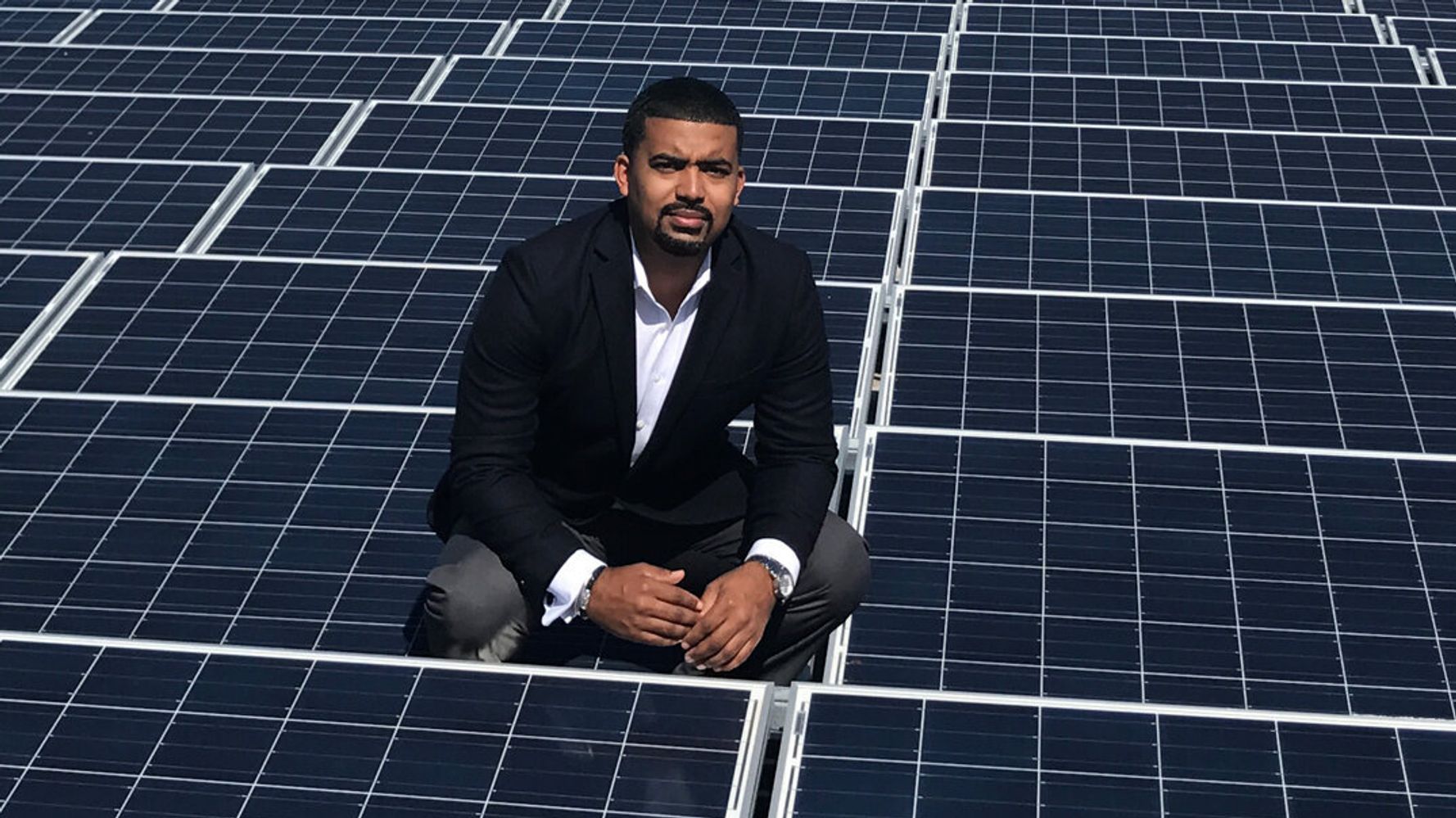[ad_1]
Gilbert Campbell co-founded the Washington, D.C.-based solar company Volt Energy in 2009 with a bold mission. The solar company aimed not only to help shift the U.S. toward a greener economy but also to bring jobs and opportunities to underserved communities.
“The fact that we’re African American-owned … we definitely have an affinity to making sure that folks who look like us are getting a fair shake, not only to get jobs but also to start their own companies,” Campbell told HuffPost.
More than a decade later, Volt Energy now works with a roster of large commercial clients, ranging from the Cheesecake Factory to the U.S. military.
The company has maintained its focus on community engagement by financing and developing smaller solar projects across the country at historically black colleges and universities, black-run churches, and black-owned businesses. These initiatives may not be the most profitable, Campbell said, but they serve as a valuable learning and recruitment tool for the solar industry.
The solar sector has a weak record on workforce diversity and there has been a spate of lawsuits alleging racism at big solar companies. Representation of black Americans and women in the solar workforce falls well below the national workforce average, putting this emerging renewable energy industry on similar footing with the fossil fuel sector, which is dominated by white men.
That is why organizations like Volt Energy see their broader mission as so vital. Industry leaders like Campbell ― who sits on the board of the trade group Solar Energy Industries Association (SEIA) ― hope to use their voices to build up progressive values, including the need for a diverse workforce, across the industry.
We still have a long way to go to build an industry that looks like the rest of America, [but] we are going to continue to work toward that goal, regardless of the circumstances.
Dan Whitten, SEIA vice president of public affairs
Under normal circumstances this would be no small task, but it has been made even harder by the threat the industry now faces from the coronavirus pandemic.
The U.S. solar industry experienced record growth last year as costs plummeted for the tenth year in a row (average prices have fallen by more than 70% over the last decade). At the end of 2019, the industry employed nearly 250,000 workers across the 50 states. But now, many of those jobs are at risk as the industry braces for a sharp economic downturn.
Layoffs have already begun and more than 106,000 workers across the clean energy sector filed for unemployment in March ― including over 16,000 in the renewable energy industry, including solar. The solar industry could lose up to half of its workers in the fallout from COVID-19, according to SEIA projections.
But during this “excruciating time,” solar companies are committed to improving diversity, Dan Whitten, vice president of public affairs for SEIA, told HuffPost.
“We still have a long way to go to build an industry that looks like the rest of America,” Whitten said, “[but] we are going to continue to work toward that goal, regardless of the circumstances.”
Boosting Diversity
There’s an expectation that clean energy companies do the right thing, said Andrea Luecke, president and executive director of the nonprofit Solar Foundation.
“The solar industry, because we are the new kids on the block [in the energy sector], we are the underdog. We have to fight harder, fight smarter, outwork, outperform, be better and have higher standards,” said Luecke. “Our cost savings have to be exponential for us to even be noticed. Everything about us has to be better because we’re trying to push over the long-standing incumbents.”
And that includes advancing diversity. The coronavirus pandemic, she said, “doesn’t change our imperative to build a diverse and equitable solar workforce. In fact, it makes this need even more urgent. As we rebuild our economy and get back on our feet, we’ll need highly skilled workers from all walks of life to ensure these businesses can succeed.”
But the solar industry has a long way to go to make good on these ambitions.
Solar companies added more than 5,550 jobs between 2018 and 2019, according to the industry-benchmarking “National Solar Jobs Census” report published by the Solar Foundation. Since 2014, solar employment has increased 44% ― that’s five times faster than job growth in the overall U.S. economy.
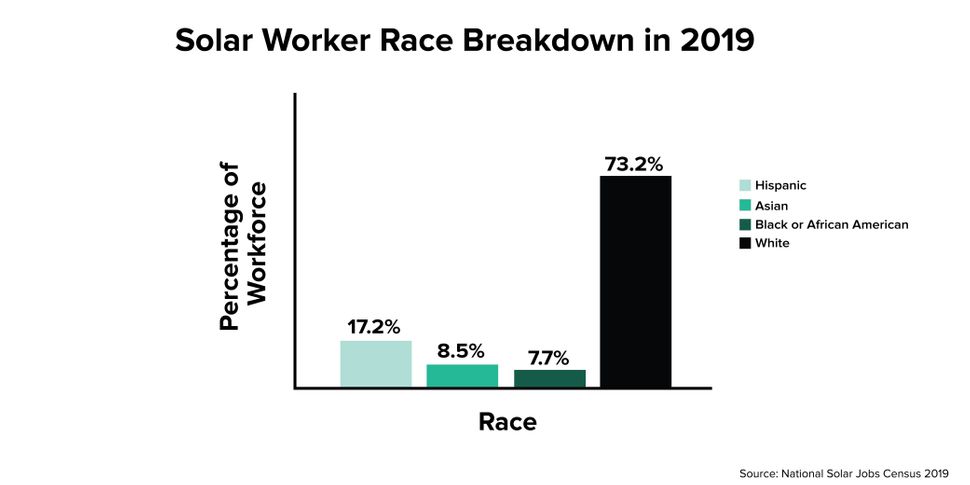
In an attempt to move quickly, the industry often fails to recruit for diversity, especially in leadership roles, Luecke said.
Black or African American employees make up only 7.7% of the solar workforce, compared to 12.3% of the U.S. workforce overall.
Female representation in solar is way behind the national average ― and getting worse, not better. Women make up 47% of the U.S. workforce, but just 26% of the solar workforce, which is down slightly from previous years (but still above the 15.8% women in mining and oil and gas extraction).
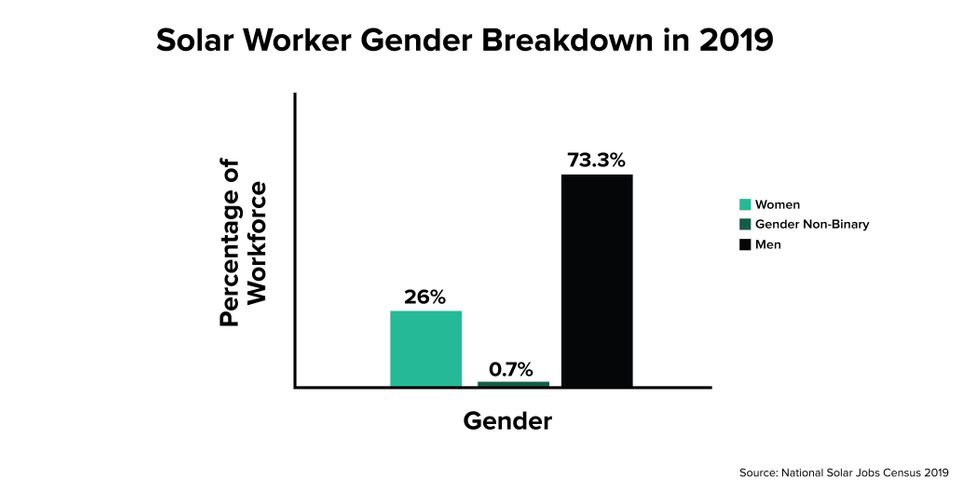
Furthermore, there is a vast underrepresentation of women and people of color at senior executive levels. While the issue is not unique to the solar industry, the gap is more pronounced for some groups. A 2018 McKinsey & Company study found that across all industries, black Americans held 4% of senior executive positions, which compares to 2% at solar companies. Women held 22% of senior executive positions in all industries, which compares to 20% in solar.
Diversity and inclusion figures for solar are not all bad, however. Last year, the proportion of solar workers who are Latinx or Hispanic increased slightly from 16.9% to 17.2%, which is comparable to their share of the U.S. workforce. Asian workers made up 8.5% of the solar workforce, holding steady year over year, but coming in higher than the 6% rate within the U.S. workforce.
Allegations Of Discrimination
Diversity is not just about the hiring process, though; it’s also about creating inclusive workplaces. Over the past few years, solar firms in California, New York and New Jersey have faced allegations of racism and discrimination from employees.
Garreth Murrell told HuffPost that he knows what it’s like to be on the receiving end of a toxic work environment.
In a lawsuit filed against New Jersey-based Momentum Solar in May 2019, Murrell contends that he was repeatedly subjected to racist comments, skipped over for promotions, and ultimately fired from the company’s New York warehouse for raising the issue with management. He has since been hired at another solar company.
Murrell said he was disturbed by his Momentum Solar colleagues’ racist comments and shocked when he got demoted and finally let go. “I grew up in Brooklyn. I’m from the middle of a melting pot,” he told HuffPost. “I’ve never experienced [discrimination] like that at work.”
He filed the lawsuit with five other plaintiffs and is now asking the court to certify it as a class action. That request was made last fall; Murrell’s lawyers expect the case will take years to resolve.
There are at least two other ongoing discrimination cases against Momentum Solar, including a complaint alleging that a female employee was terminated when the company found out about her high-risk pregnancy.
In Murrell’s case, Momentum Solar’s lawyer, Michael Marotte, acknowledged that the company had “a bad, rogue employee” who made racist comments. He said that the employee was fired as a result. “With 2,000 employees we can’t control what each of them does,” he told HuffPost. “Certainly, what that employee did was not acceptable under any circumstances.”
Marotte contended that Murrell and the other plaintiffs, meanwhile, were terminated for nondiscriminatory causes, including poor performance. He rejected allegations that Momentum Solar has broader issues with discrimination.
The lawyer said the company is “very progressive by nature,” adding that African Americans make up nearly 23% of Momentum’s workforce, which is almost double the national workforce representation.
More Than A ‘Pat On The Head’
Increasing diversity isn’t just the right thing to do ― there’s a business case for it. Research shows that diversity and inclusion give companies a competitive advantage. Hiring and promoting employees with a wide range of backgrounds can also help firms reach a broader set of customers.
Campbell at Volt Energy recommends putting women, people of color, veterans and other diverse representatives on company boards to help guide business strategy. Recently, Volt’s racially diverse, yet all-male, advisory board added a woman, who was also hired to lead the company’s STEM education program. Volt is also hiring a woman to run its business development team. Campbell acknowledged there’s more room for improvement and said he aims to add two more women to the board as soon as possible.
To help promote diversity beyond Volt, Campbell prioritizes hiring subcontractors with diverse backgrounds or minority-owned firms to install the company’s photovoltaic panels on roofs. He is also in early talks with utilities to facilitate the hiring of ex-offenders into the clean energy sector.
Because we are the new kids on the block, we are the underdog. We have to … be better and have higher standards.
Andrea Luecke, president and executive director of the Solar Foundation
The Solar Foundation and SEIA partnered last year to create a best practices guide for promoting a more diverse and inclusive workforce. Recommendations include offering leadership training in diversity, inclusion and cultural competency.
Increasingly, solar companies are listening. The percentage of firms with a strategy in place to increase the representation of women, for instance, tripled between 2017 and 2019, according to a Solar Foundation diversity report last year.
Formal and informal mentorship is critical to career advancement, according to 90% of solar employees surveyed by the Solar Foundation last year. Only 37% of companies specifically offer mentorship opportunities. But NEXTracker, a solar equipment company with 375 employees headquartered in San Francisco, is now one of them. In March, it launched a women’s network to connect female employees with mentors.
Meanwhile, solar tracker manufacturer Sunfolding, also based in San Francisco, is offering an incentive to employees who refer a new hire who identifies as a woman, LGBTQ or an underrepresented minority in a STEM field. As the company doubled in size last year, this program helped it surpass the industry average for female representation ― reaching 28% compared to the industry’s 26%.
Diversity and inclusion efforts have to be more than side tasks to work, said Kristen Graf, executive director of Women of Renewable Industries and Sustainable Energy. The organization, founded in 2005, runs a mentorship program, hosts networking events and works with clean energy companies to help them hire and promote more women.
“When I started in this work [a decade ago], it was more of a patronizing pat on the head [from business leaders],” Graf said. “It was like: ‘You do that thing over there, we’ll do the real business over here.’”
Times are changing. Solar industry leaders like Abigail Ross Hopper, president and CEO of SEIA, are making diversity and inclusion a priority, Graf said. But diversity should not be seen as a singular problem to be fixed, she added. It needs to be integral to the business.
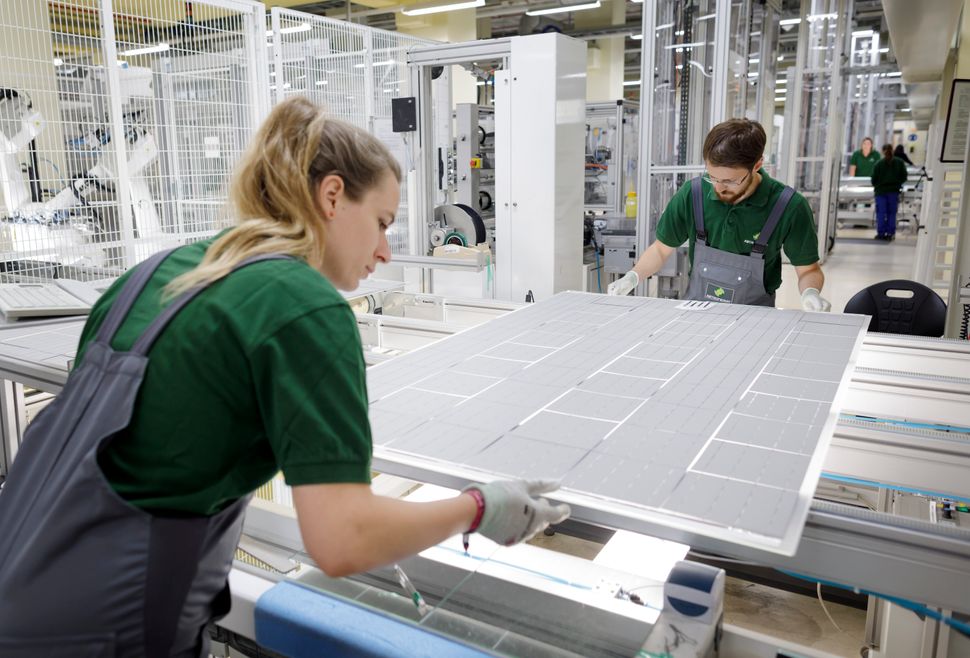
“There is no point in time where you’ve met your goal on safety and you don’t have to worry about it anymore,” she said. “That is how we need to think about diversity overall. How are we building companies with a cultural perspective where it permeates everything that we do?”
The energy sector as a whole may be slow to move, said Graf, but clean energy companies, which are typically younger, can accelerate this shift. Corporate culture is established from a company’s very first hires. So rather than put on blinders to diversity until a startup matures, Graf said, inclusivity should be woven in from the beginning.
“Change is not going to come easy and it’s not going to occur overnight,” echoed Luecke at the Solar Foundation. “But it’s worth doing.”
“If we want to have ubiquitous solar, if we want to take on the fossil fuel industry, if we want to have 100% renewable energy and solve for climate change, then we’re going to have to have every single person’s participation,” she said.
A Way Forward
In Washington, Destiny Hodges, a sophomore at Howard University and founder of the school’s Student Sustainability Committee, is coordinating with Volt Energy to install solar panels at the historically black college. She said youth of color need more opportunities to enter the green economy and more role models like Campbell.
“To see a black man leading a solar company is important,” said Hodges.
She also wants to see the industry thinking more about how solar power can be part of the solution to social and environmental justice issues. Especially as the effects of climate change set in, she fears societal inequities will only become more severe.
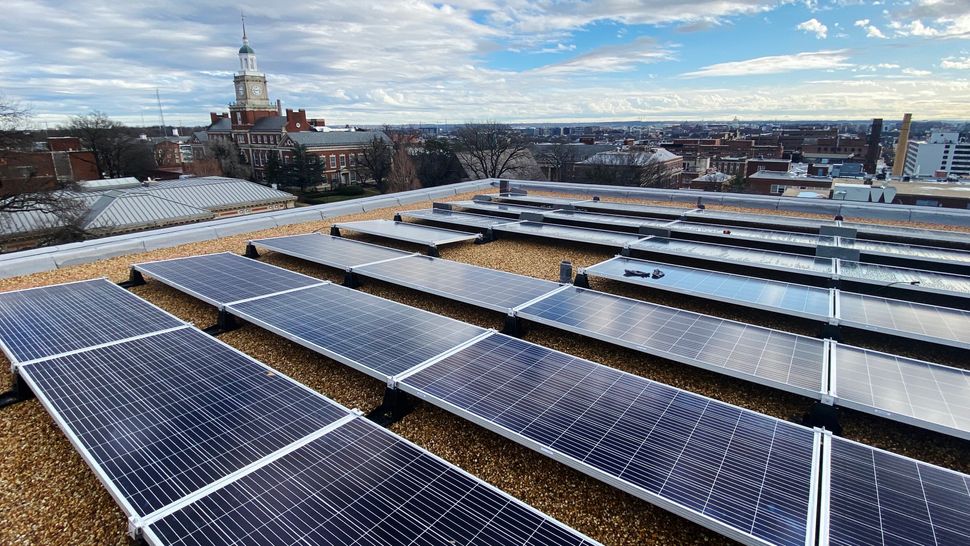
In addition to creating new employment opportunities for disenfranchised populations, expanding the use of renewable energy will reduce fossil fuel pollution, which disproportionately impacts communities of color.
This is of heightened concern during the coronavirus crisis, as evidence shows that exposure to air pollution can make people more vulnerable to the virus and that Black people are dying at higher rates from COVID-19. Meanwhile, countless reports already show how the pandemic is exacerbating income inequalities as millions file for unemployment benefits.
With the right policies in place, the solar industry can be part of the country’s economic recovery, Campbell argues. As Congress works to pass the next coronavirus stimulus bill in response to skyrocketing unemployment, he said, “We need to look back, before the pandemic, at the industries that were driving jobs, and the clean energy industries are that.”
“We’re at a crossroads,” Campbell said. “As we’re talking about rebuilding our infrastructure, are we going back to the ways of the past and building infrastructure that’s making people unhealthy? Or are we going to move forward and build infrastructure that’s going to provide cleaner air, cleaner water and more jobs?”
This story is a part of Covering Climate Now’s week of coverage focused on climate solutions, to mark the 50th anniversary of Earth Day. Covering Climate Now is a global journalism collaboration committed to strengthening coverage of the climate story.
For more content and to be part of the “This New World” community, follow our Facebook page.
HuffPost’s “This New World” series is funded by Partners for a New Economy and the Kendeda Fund. All content is editorially independent, with no influence or input from the foundations. If you have an idea or tip for the editorial series, send an email to [email protected].
Calling all HuffPost superfans!
Sign up for membership to become a founding member and help shape HuffPost’s next chapter
[ad_2]
Source link

